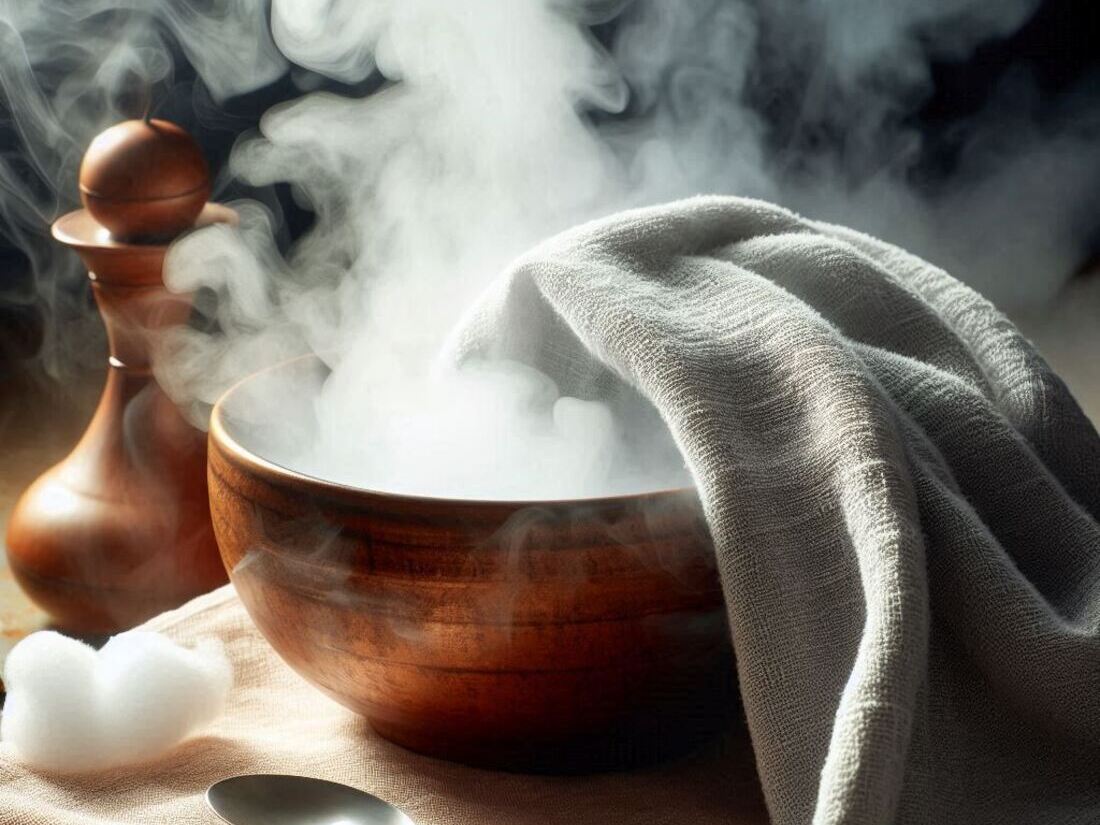You wake up with a scratchy throat, a stuffy nose, and a chest that feels like it’s filled with cotton balls.
A cold or the flu has struck again, leaving you feeling miserable and yearning for relief.
While medications can help manage symptoms, sometimes you just want a natural, at-home solution to clear your congestion and breathe easier.
Enter the power of steam!

Steam inhalation has been used for centuries as a home remedy for respiratory ailments.
The warm, moist air can help loosen mucus, soothe irritation, and promote drainage, offering temporary relief from the discomfort of a cold or chest congestion.
But is steam therapy right for you? This blog dives deep into the world of DIY steam treatments, exploring their potential benefits, safety considerations, different methods, and how to create a DIY steam session at home.
The Struggle is Real: Understanding Chest Congestion and Colds

Colds and the flu are common respiratory illnesses caused by viruses.
These pesky invaders can trigger a cascade of unpleasant symptoms, including:
- Runny or stuffy nose
- Sore throat
- Cough
- Chest congestion
- Fatigue
- Body aches
Chest congestion, characterized by a feeling of tightness or fullness in the chest, occurs when mucus production increases in the airways.
This can make breathing difficult and lead to a persistent cough.
While most colds and flu resolve on their own within a week or two, the struggle to breathe can be particularly bothersome.
Luckily, steam therapy offers a natural way to find some relief.
Key Takeaways
- Steam inhalation is a traditional home remedy for chest congestion and colds.
- Warm, moist air can help loosen mucus, soothe irritation, and promote drainage, offering temporary relief from symptoms.
The Science Behind Steam Therapy: How Does it Work?

The exact science behind steam therapy’s effectiveness is still being explored, but here are some potential benefits:
- Hydration: Steam adds moisture to the air, which can help thin mucus and make it easier to expel through coughing or blowing your nose.
- Soothing Irritation: The warm mist can soothe irritated tissues in the nose, throat, and airways, easing discomfort and reducing the urge to cough.
- Decongestion: Moist air may help loosen mucus buildup in the nasal passages and sinuses, promoting drainage and relieving congestion.
Important Considerations Before You Steam
While generally safe for most people, there are a few things to keep in mind before using steam therapy:
- Consult your doctor: If you have a pre-existing lung condition, such as asthma or chronic obstructive pulmonary disease (COPD), talk to your doctor before trying steam therapy.
- Not suitable for everyone: Steam inhalation is not recommended for young children, people with a high fever, or those prone to nosebleeds.
- Scalding risk: Be cautious of hot water to avoid burns.
DIY Steam Treatment Methods: Find What Works for You!
There are several ways to create a DIY steam treatment at home.
Here are a few popular methods:
- Hot Shower: The simplest method! Take a hot shower and breathe in the steam for 10-15 minutes. Close the bathroom door to trap the steam, and consider placing a towel over your head for a more concentrated effect.
- Steam Bowl: Boil a pot of water and carefully pour it into a large bowl. Place your face a comfortable distance away from the bowl (at least 12 inches) and drape a towel over your head to create a tent. Breathe deeply in through your nose and out through your mouth for 10-15 minutes.
- Facial Steamer: For a more convenient option, consider using a facial steamer. These devices create a gentle stream of warm mist that you can inhale directly.

Pro-Tips for a More Effective Steam Session
- Add essential oils: A few drops of eucalyptus, peppermint, or tea tree oil (diluted in a carrier oil) can be added to the hot water for their potential decongestant and soothing properties. (Important Note: Always consult with a healthcare professional before using essential oils, especially if you have any health conditions or are pregnant or breastfeeding.)
- Stay hydrated: Drink plenty of fluids before, during, and after your steam session to help loosen mucus further.
- Elevate your head: Prop yourself up with pillows while inhaling the steam to promote drainage.
- Relax and repeat: Aim for 2-3 steam sessions per day, each lasting 10-15 minutes.
Safety First: Important Precautions During Steam Therapy
- Avoid burns: Never place your face directly over the hot water. Start at a comfortable distance and adjust as needed.
- Don’t overdo it: Limit your steam sessions to 10-15 minutes at a time, and avoid using steam therapy for more than a few days in a row.
- Listen to your body: If you experience any discomfort, such as dizziness, difficulty breathing, or worsening symptoms, stop the steam treatment immediately and consult your doctor.
Who Can Benefit from Steam Therapy?
Steam therapy can be a helpful addition to your home care routine for:
- Chest congestion: The warm, moist air can help loosen mucus and ease congestion, making breathing feel easier.
- Common cold: Steam inhalation may offer temporary relief from a stuffy nose, sore throat, and cough associated with the common cold.
- Sinusitis: Steam therapy can help moisten the sinuses and promote drainage, potentially reducing sinus pressure and discomfort.
While steam therapy is generally safe for most healthy adults, it’s crucial to consult your doctor if you have any concerns, especially if you:
- Have a pre-existing lung condition like asthma or COPD.
- Experience a high fever.
- Have a history of nosebleeds.
- Are pregnant or breastfeeding.
Frequently Asked Questions (FAQs) About Steam Therapy
- How often can I do steam therapy?
Aim for 2-3 steam sessions per day, each lasting 10-15 minutes. However, it’s best to listen to your body and stop if you experience any discomfort.
- Can I add essential oils to my steam treatment?
While some essential oils like eucalyptus, peppermint, or tea tree oil may offer additional benefits, consult your doctor first. Avoid using essential oils directly in the steam or if you have any health conditions, are pregnant, or breastfeeding.
- Is a facial steamer better than a hot shower or bowl of water?
Facial steamers offer a convenient and controlled way to receive steam therapy. However, a hot shower or bowl of water can be just as effective if done safely.
- What if steam therapy doesn’t help my cold symptoms?
Steam therapy is a temporary relief measure. If your cold symptoms persist or worsen, consult your doctor. in addition to steam, there are other home remedies and medications that can help manage cold symptoms.
Related Products for DIY Steam Therapy
While this blog focuses on DIY steam treatments, here are some top-selling and well-reviewed products that can enhance your experience:
- Facial Steamer: This portable device allows for convenient and controlled steam inhalation at home. Look for models with adjustable settings and a comfortable design. Here are two popular options:
- Miroco Nano Ionic Facial Steamer: The Miroco Nano Ionic Facial Steamer is a top seller on Amazon, renowned for its ability to produce fine nano steam that penetrates deep into the skin. It’s designed for deep cleansing and hydration, with a large water tank capacity for extended use. Customers have given it high ratings for its ease of use and the spa-like experience it provides at home. (Note: Affiliate Link)
- Crane Facial Steamer & Humidifier: This 2-in-1 device serves as both a facial steamer and a humidifier, making it a versatile addition to any home. It’s well-regarded for its effectiveness in relieving congestion and its additional humidification benefits. With a substantial number of positive reviews, users find it an essential tool for personal care. (Note: Affiliate Link)
- Essential Oils (Consult Doctor Before Use): Consider adding a few drops of essential oils like eucalyptus, peppermint, or tea tree oil (diluted in a carrier oil) to your steam treatment for their potential decongestant and soothing properties. However, always consult with a healthcare professional before using essential oils, especially if you have any health conditions or are pregnant or breastfeeding. (Note: Affiliate Link)

Remember: Consult your doctor before using essential oils and prioritize consulting a healthcare professional if your cold symptoms persist or worsen.
Complementary Practices for Faster Recovery
Steam therapy can be a valuable tool, but it’s not a magic bullet.
Here are some additional practices to consider for a faster recovery from a cold or chest congestion:
- Rest: Getting plenty of sleep allows your body to focus on healing.
- Hydration: Drink plenty of fluids to loosen mucus and prevent dehydration.
- Humidifier: Using a cool-mist humidifier can add moisture to the air, especially at night, for easier breathing.
- Over-the-counter medications: Consult your doctor about pain relievers, decongestants, or cough suppressants to manage specific symptoms.
- Saltwater gargle: A saltwater gargle can soothe a sore throat.
The Road to Recovery: It’s a Journey, Not a Destination
There’s no one-size-fits-all approach to recovering from a cold or managing chest congestion.
By combining DIY steam therapy with other home remedies, healthy habits, and potentially consulting your doctor, you can create a personalized strategy to feel better faster.
Here are some additional tips for a speedy recovery:
- Healthy diet: Nourish your body with nutrient-rich foods like fruits, vegetables, and whole grains to support your immune system.
- Warm compress: Apply a warm compress to your chest or forehead for additional comfort and relief from congestion.
- Manage stress: Chronic stress can worsen symptoms. Relaxation techniques like deep breathing exercises or meditation may be beneficial.
- Chicken soup (or broth): Warm chicken soup or broth can be soothing and help loosen mucus.
- Elevating your head: Prop yourself up with extra pillows while sleeping to improve drainage and ease congestion.
Remember: Steam therapy is a complementary therapy, not a replacement for professional medical advice. If your symptoms persist or worsen, consult your doctor to rule out any underlying conditions and create a personalized treatment plan.
Call to Action:
- Share this blog with friends and family who might be interested in learning about DIY steam treatments and home remedies for chest congestion and colds.
- Leave a comment below and tell us about your favorite home remedies for colds and congestion.
- Take charge of your health! By incorporating these tips and consulting your doctor when needed, you can navigate the sniffles and coughs of cold and flu season with a little more ease.

Citations
- Mayo Clinic: https://www.mayoclinic.org/diseases-conditions/common-cold/symptoms-causes/syc-20351605
- National Institutes of Health (NIH): https://www.nih.gov/
- Centers for Disease Control and Prevention (CDC): https://www.cdc.gov/
Disclaimer:
The information in this blog is for educational purposes only and should not be construed as medical advice. Always consult with a healthcare professional for personalized guidance on managing your cold or chest congestion and the suitability of steam therapy or other home remedies for your individual needs.
